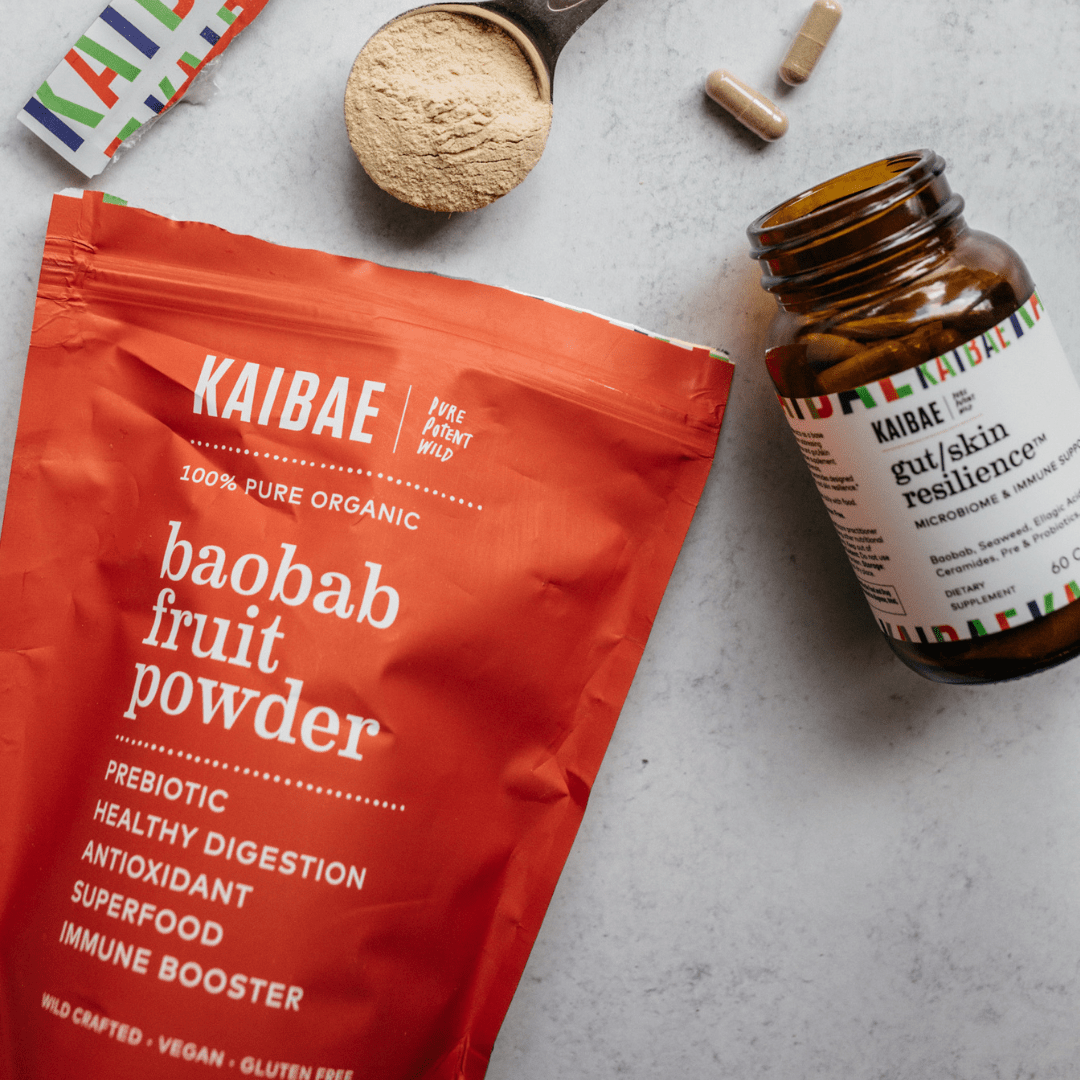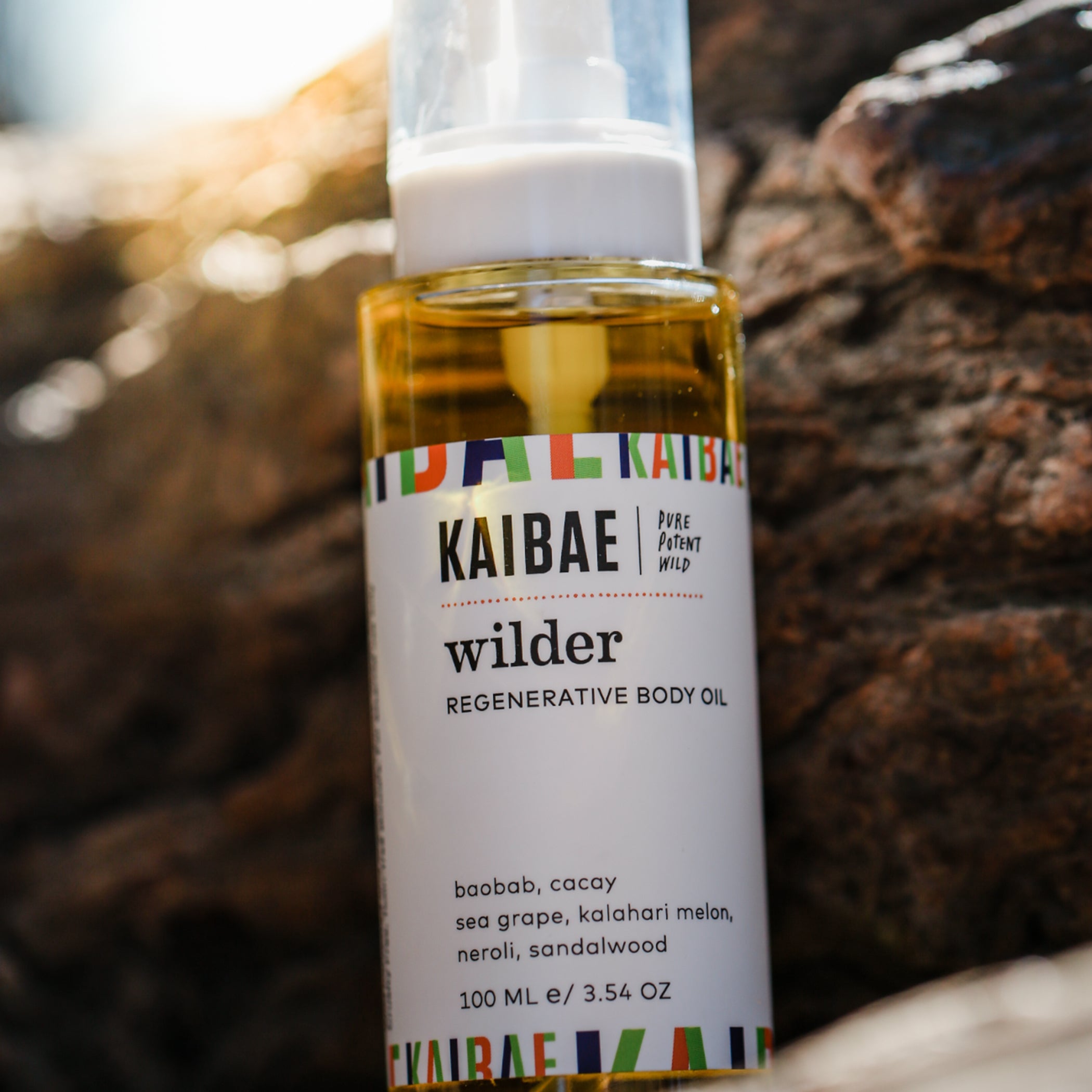Fiber: The Key to Increasing Muscle Mass and Strength

Improve Your Gut-Muscle Axis, Improve Performance
Maintaining muscle mass and strength is essential throughout life, whether you are a seasoned athlete or a weekend warrior. While protein and carbohydrates typically come to mind when considering building muscle, we’re discovering that fiber and a wide range of plant bio-actives play an equally important role in supporting muscle health. A great case study for these effects is the baobab fruit, an African superfood, which has provided the active Hadza a hunter-gatherer tribe in Tanzania with strength and energy for millennia. The strength-supporting benefits of Baobab are attributed to the fruit’s unique synergy of powerful nutrients, which help nourish the body’s gut-muscle axis.
What is the Gut-Muscle Axis?
By now most of us know that the gut microbiome is central to many aspects of our health, from the immune system (gut-immune axis), to the lungs (gut-lung axis), brain (gut-brain axis), and skin (gut-skin axis). However, recent research has revealed how the gut microbiome also impacts muscle, through the gut-muscle axis. A study published in the journal Frontiers in Medicine 2022 showed that mice experienced impaired muscle growth after antibiotics indicating that the gut microbiome plays a role in the growth of skeletal muscle.
Probiotics and prebiotic fiber promote muscle health, increasing healthy gut microbiota that produce metabolites called short-chain fatty acids, including butyrate, acetate, and propionate. More recently, a new class of compounds, bacteria derived bile acids (BSH), have emerged as critical cell-signaling molecules involved in the metabolism of FGF19 (Fibroblast growth factor 19) which helps protect skeletal muscle health.
How Short Chain Fatty Acids Benefit Muscle Mass?
Let’s take a closer look how and why short-chain fatty acids (SCFAs) play such and important role in the gut-muscle axis. Acetate, propionate, and butyrate are metabolites generated by gut bacteria through the fermenting dietary fibers in the colon. Research shows that these fatty acids play an essential role in various physiological processes benefitting brain, nervous system, cardiovascular system, skin and muscles.
A source of energy: SCFAs which are not taken up by colonocytes (gut cells) are used in the liver and other tissues, including muscle cells. Researchers found that short chain fatty acids improved glucose uptake.
Anti-Inflammatory: SCFAs, especially butyrate, have anti-inflammatory properties. Chronic inflammation can contribute to insulin resistance and muscle wasting. By reducing inflammation, SCFAs may indirectly support skeletal muscle health.
Enhance Insulin Sensitivity: Some studies suggest that SCFAs, particularly propionate, may enhance insulin sensitivity. Improved insulin sensitivity is beneficial for skeletal muscle, as it helps facilitate glucose uptake and utilization.
Formation of muscle tissue: There is evidence to suggest that SCFAs may influence the process of myogenesis, which is the formation of muscle tissue. Butyrate, for example, has been shown to promote the differentiation of myoblasts into mature muscle cells.
Enhance Performance: Some animal studies have suggested that SCFAs may enhance exercise performance and endurance. The mechanisms behind this potential effect are not fully understood, but may involve improvements in energy metabolism and mitochondrial function.
The Important Role of the Gut-Muscle Axis
Our muscles are essential to our mobility and overall wellbeing. Unfortunately, muscle mass decreases (sarcopenia) as we age, increasing our susceptibility to injury, fractures, and slow recovery. Lean body muscle mass starts to decline approximately 3–8% per decade after the age of 30 with muscle strength decreasing as much as three times faster. However, this does not mean you are helpless to slow it down. In addition to exercise, there are several simple dietary measures that can help muscle health by nurturing the gut-muscle axis.
Improve Your Diet to Increase Muscle Mass
Diet provides the building blocks for muscle mass and strength and requires a balanced intake of protein, carbohydrates and fats depending on our activity requirements. The latest research into the gut-muscle axis illustrates that that a diet that supports gut health increases the bioavailability of nutrients to all our tissues.
Protein: The body breaks protein into amino acids, which it uses to build muscle. As we age, anabolic resistance lowers the body's ability to break down and synthesize protein, requiring increased protein intake. While some of these metabolic changes may be a product of the natural aging processes, improving gut microbiome balance through lifestyle modifications (diet, exercise, sleep, and reducing medication) we are able to improve anabolic capacity in our older years.
Creatine is an amino acid commonly used to improve muscle mass actually has a broad range of health benefits (pleiotropic) that starts with the gut barrier in the prevention of leaky gut syndrome
A study in the journal Nutrients recommends a daily intake of 1 to 1.3 grams of protein per kilogram of body weight for older adults who do resistance training. For example, a 180-pound man would need about 80 to 108 grams of protein daily.
Fiber: A fiber-rich diet increases microbial diversity in the gut and thus may support the gut-muscle axis in mitigating anabolic resistance. In addition to baobab fruit powder, prebiotic fiber is found in fruits and vegetables such as chicory root, Jerusalem artichoke, garlic, onions, leeks, asparagus, bananas, apples, oats, and flaxseeds. The amount of prebiotic fiber varies from plant to plant. Baobab fruit powder is very high in prebiotic fiber and anti-inflammatory polyphenols, which makes the ancient African superfood ideal for daily gut-muscle axis support.
Carbohydrates: If you want to preserve muscle mass, you need protein, but you also need carbohydrates as fuel for muscles to replenish glycogen stores to prevent breakdown and help recovery. Fiber-rich complex carbs from whole foods (such as fruit, veggies, and whole grains) should be taken during rest days and use simple carbohydrates before and during activity.
Fats: A short workout will use carbohydrates for energy, but as you push through and do a longer session, our bodies burn fat for fuel. Fat-soluble vitamins are stored in fat and if your body fat is too low you won't be able to hold on to these important nutrients, which prevents your body from performing optimally. Fats from avocados, olive oil and fatty fish reduce inflammation and support cardiovascular health.
Polyphenols: There are an estimated 8,000 polyphenols which are found in fruits, vegetables, such as berries, grapes, green tea, coffee, and citrus. Wild plants such as baobab produce an exceptionally diverse and large amount of these phytonutrients as a defense mechanism from pathogens and UV radiation. Polyphenols have a wide range of health benefits, and there is growing support that they enhance muscle tissue formation and metabolic function.Quercetin, for example, is found in plants such as Baobab and Buckwheat and known as an antioxidant with anti-inflammatory effects, improving muscle glycogen content and decreasing oxidative stress.
Vitamin C: Supplementation of Vitamin C helps to preserve muscle mass as we age. Research shows that older people who eat plenty of vitamin C have the best skeletal muscle mass. Citrus fruits like oranges are known for their vitamin C content, but Baobab Fruit Powder has 6 times more vitamin C than even oranges.
How to Support the Gut-Muscle Axis?
Including organic Baobab powder in your daily diet is a great way to get an abundance of nutrients that support the gut-muscle axis” says Dr. Luc Maes, ND, founder of KAIBAE. “This amazing superfood has so much more to offer over other prebiotics such as inulin and resistant starches such as Fibersol (corn starch) and Solnul (Potato starch). Baobab powder provides a 3 in 1 solution for the gut-muscle axis (1) prebiotic fiber, (2) bioavailable vitamin C and (3) anti inflammatory polyphenols.”
What is Baobab Fruit Powder?
The Baobab is an amazing tree that grows in the African Savanna. Once considered a lost crop, the magical Baobab tree produces a fruit powder with immense health benefits. Baobab fruit powder is an immune-boosting superfood, an excellent source of prebiotic fiber, bioavailable vitamin C, antioxidant polyphenols and minerals including calcium, magnesium and potassium. For muscles, the fiber in Baobab helps to activate probiotics that produce metabolites that support the gut-muscle axis.
How To Use Baobab?
Baobab Fruit Powder tastes sweet and tangy and can be added to smoothies, yogurt, oatmeal or granola. Baobab Powder is a raw ingredient, gluten free and free of additives. Get ready to pump those muscles like a pro with Baobab's amazing power to aid the gut-muscle axis!
Take Away
-
Whether you are an athlete or a weekend warrior, support muscle health with a balanced diet, including protein, carbohydrates, fiber and fat.
-
Maintaining muscle mass and strength supports performance and prevents injury.
-
The gut microbiome influences bioavailability of nutrients including protein.
-
Fiber, polyphenols and vitamin C support gut microbiome and muscle health.
-
Baobab powder is a great source of fiber and essential nutrients that support the gut-muscle axis.






















